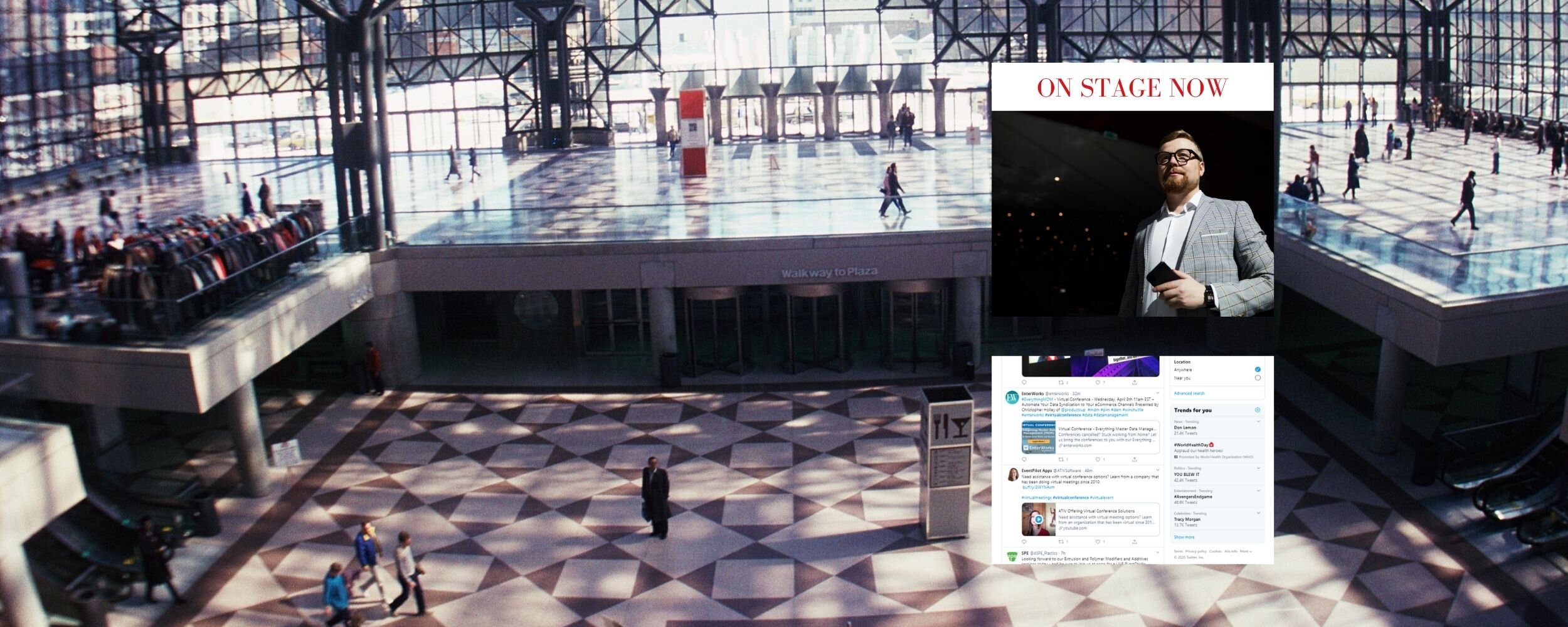Switch a Conference to a Virtual Conference
The uncertainty of live events in 2020 is completely up in the air as it’s impossible to speculate when this pandemic will be over, as well as, when people will feel comfortable attending an event with a large group of people.
Virtual events can alleviate that uncertainty.
I’m a firm believer in live events, however, virtual events with some creativity and planning can be just as engaging as a live event.
The below blog post provides information for you to gauge on whether a virtual event could work as a temporary replacement for a live event (or keep it virtual or make it a hybrid).
Questions to Answer Before Going Virtual
Does your audience have the ability and/or desire to engage in a virtual conference?
Do you want attendees to just view or will they participate (i.e. ask questions, take polls, etc.)?
Do you want the event to be live, pre-recorded or a mix of both?
Will it be a revenue generator or a freebie?
What will be the program?
Single speaker with live Q&A
Multiple speakers with breakout sessions
Multiple tracks of learning (i.e. marketing track, sales track, operations track, etc.) where an attendee would follow one track that would provide multiple speakers and breakout sessions
* Don’t just string together a bunch of webinars and call it a day. That will not provide the engagement your attendees seek.
Virtual Event Options Available
Virtual Events can be jaw-dropping. Full buildouts of what looks like a convention center with trade booths lining the walls and people walking around. It’s amazing what developers have done.
Below are some options available, keep in mind the more intricate the more it may cost.
Live Webinars
Breakout sessions
Virtual Lobbies
Virtual Trade Show: Each booth can include a video presentation, downloads, live chats with attendees, direct messaging and feeds to their social media accounts.
Real time chat tools with attendees to make it a 2-way conversation
One-on-one networking
Different ticket levels that provide specific event access
Create live chats with presenters
Poll attendees
Share information in the form of videos, documents, and presentations
Download post event reports to learn what worked, didn’t work and how to improve for future events. These detailed reports can provide the data for attendee engagement and sponsor ROI.
The Process To Planning A Virtual Event
Set Goals. When companies set goals, they achieve far more than when they don’t. First you need to decide your overall vision for the event (including programming) and what the User Experience (UX) will be from the moment they register to post event communication. Then mesh that vision with goals and metrics that help to maximize the exposure your virtual event will have on the target attendee. Below are some examples (don’t chose multiple goals, decide on one and make it happen).
We will set a goal of 500 attendees
We will acquire 200 new email subscribers
We will complete 100 complimentary consultations during the event
We will set 10 appointments with new clients by 2 weeks after event
Create a Budget. Setting a budget is crucial to the financial success of an event. By just stating a number (whether that’s gross revenue or net profit) doesn’t mean you will achieve it if you don’t define all of the line items involved.
Revenue:
Ticket Sales. There can be different levels that receive different access, plus you will be tapping into attendees that would not be able to attend otherwise.
Exhibitor Sales. This is self-explanatory.
Sponsorship. One of the biggest concerns regarding revenue for virtual events is whether corporate sponsorship can stay the same levels as they were for a live event. You can argue both sides of this, but the great thing about this is at the end of event you will have the data from reports to back up the ROI.
Expenses (** denotes expenses for creating the stage setup yourself):
Audio Equipment. This cost ranges from $35 for a headset up to $100+ for a lavalier microphone. **
Cameras. To provide the video range from $200 - $10,000+ depending on how high quality you want to go (or just use your computer). **
Lighting. This cost ranges from $45 for a small ring light up to $150+ for stage lighting. **
Marketing. This could be done for free using your email list and social media posts, or you could spend $50 - $5,000+ on digital ads. Also, you can create a lot of graphics on your own for free on Canva.com (my all-time favorite platform).
Speaker Fees. This fee is dependent on the speaker’s credibility, follower count and their popularity. They could do it for free or cost $20,000+.
Staging/Background. A backdrop could just be a wall or you could purchase a screen (of varying colors) and the frame to hold it up for $100+ depending on size. NOTE: keep the height of person in mind when picking the size of the screen (unless they are seated then it won’t matter). **
Video Conference Platforms. The pricing is usually based on how many participants, how many meetings/conferences you will hold and how much cloud storage is needed. Monthly rates start at $15 on up past $100 per month.
IMPORTANT: Please DON’T base your decision to hire a vendor purely on price, get references and check online ratings. I’m sure you’ve heard the term “you get what you pay for” it’s not something you want to learn during a stressful event, especially if it’s the first time you’re doing it.
Finding the Right Vendors. Thankfully you will not need as many vendors as a live event, it mainly comes down to just a handful.
Audio Visual (A/V) equipment companies can help with the audio equipment, lighting, camera/computer and staging. Please ask their advice on what equipment would work best for your event vision AND give them the budget upfront. For the most part A/V companies can work with most budgets. However, if your budget is $200 for a full setup, they probably won’t be able to work with that.
Online Platforms (the companies referenced below are for your convenience and not an endorsement)
Marketing for a Virtual Event. The same platforms to promote a live event direct emails to your list, social media posts, posting on online calendars and advertising with digital ads on relevant sites work well.
But the most important part is what content you should share. The goal is to entice ticket sales and/or social media sharing. Below is a good list of content to post:
Previous video interviews with scheduled speakers
Relevant industry info: blog posts, white-papers, eBooks
Downloadable offers
Event updates (new speakers, flash sales for tickets, conversations on social media groups)
Create a hashtag for your event, it serves two purposes to push the word out as well as a location for attendees to submit questions before or during a talk from a speaker.
Event Preparations. There is a lot of preparation that goes into a successful virtual event. It would be great if you just hired the online platform and they handled it all from there, but that’s not reality. Below are some tips to get ready for day of event.
Event Website. A virtual conference website, depending on the complexities, could take 1-2 weeks to set up. This means writing the copy, creating the graphics, setting up the branding, designing booths (if applicable), uploading content and scheduling webinars. Major customizations can take more time.
Presenter’s A/V. Once securing each presenter, find out their audio and visual capabilities, as well as, the strength of their wi-fi connection. Ideally, they will have a similar setup to keep a consistent look for the event AND you don’t want them dropping the connection during their presentation due to weak wi-fi.
Presenter Prep. Even with live events, it’s necessary to have a conversation with presenters on their talking points to make sure that they are touching on the important topics your attendees are expecting to hear. Also, ask them how you can support them in the event to make their presentation more engaging.
Rehearsals. Schedule a rehearsal with each of your presenters and test attendees. Work on the polling and chat sessions to make sure your presenter is comfortable with the screen controls and function of the presentation.
Presenter Problems. Create a plan (and rehearse it) for any problems that may arise if a presenter loses connection, is running late, or cancels last minute.
Attendee Tutorial. Create a tutorial on the event website and send via email, explaining how to join webinars, ask questions, join networking and breakout sessions. The tutorial could be a quick video showing screenshots or simple text with imagery.
Customer Support During Event. It’s important to have a person designated to provide support/help to attendees during the event. This can be via email, phone or web chat. If you don’t have a staff person or it’s not available with the online platform you choose, consider outsourcing a staff member from an agency or online staffing platform.
Reminders. Reminders are incredibly important for virtual events, it’s very easy to receive a reminder and forget to login because something comes up. Send out reminders the day before, 1-hour before, and 10-minutes before the event starts.
Post Event Action Items. Now that the event has concluded, it’s time to thank the appropriate people and get the data.
Thank You’s. Send out a thank you email within a day of event closing. Make sure to include sponsor logos (with hyperlinks if possible), presenter decks (if approved) and event survey.
Run the Reports. The best thing about virtual events, is the online platform is extracting data during the whole process. Measuring the ROI is simplified and sending that data to sponsors is so much easier.
* If possible, encourage attendees to keep the conversation alive in the social media groups. This can help with furthering your attendee engagement and possibly help to recruit attendees for future events.
Hopefully this post has provided you the information to move forward (if appropriate) with a virtual conference.
Also, over the past 6-8 years many events have moved and stayed online, something to consider for the future. Another option is a hybrid event - virtual and live (i.e. pre-event and post event stays virtual to start and keep the conversation going with a live event).
Please comment below with virtual projects you have completed and how it resulted. Crowd sourcing information helps everyone.
Want more ideas on how to make corporate events bigger, better and A LOT more fun, subscribe to our monthly eNewsletter.


